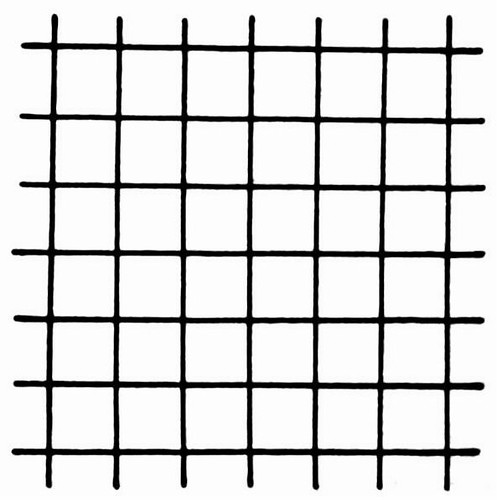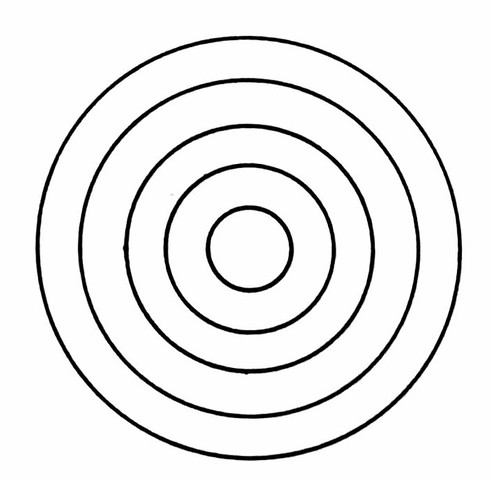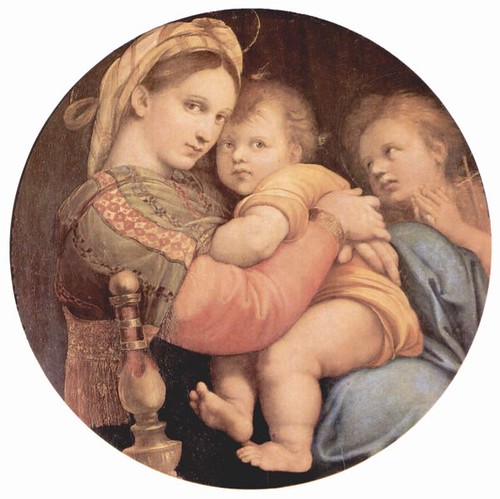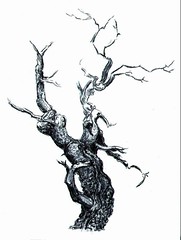Before you start reading this post...
First (bear with me!), I'll provide a very short review of the Cartesian grid and the concentric system -- Not so boring as you may think! (Okay, maybe a little boring, but not complicated.) -- and then some examples of round artwork (tondos) are analyzed, below. You may be surprised at how helpful this might be if you're an artist and aren't already aware of how some subjects are more suitable for a round format than a rectangular format, and that there are different things to consider when you're composing a round picture.
There are two previous posts that you might want to read before you read this one (or you may prefer to go ahead and read this, then go to the others to understand this post a little better if the subject interests you). Here are the earlier posts:
Art, Gravity, Life, and the Cartesian Grid
In reading this present post (on this page) for the first time, you may want to zip through or even skip the first part (about the Cartesian grid and the Concentric system), or just look at the pictures and read the "In a Nutshell" parts. You can always come back to the first part if you're interested in learning more.
 |
Planet Earth as seen from Apollo 17
Courtesy NASA/JPL-Caltech
We live on a round world but because of gravity we make use of a very non-round spatial system, the Cartesian grid, for practical purposes, in order to make things, understand things, etc. (see my earlier post, Art, Gravity, Life, and the Cartesian Grid to understand why).
| IN A NUTSHELL: Although the earth is round, "in the parochial view of its small inhabitants, the curvature of the earth straightens into a plane surface, and the converging radii become parallels." (Rudolf Arnheim in the book The Power of the Center) -- The Cartesian grid represents the parallel verticals and horizontals that are so important in our lives here on Earth. |
 |
The Cartesian Grid "A co-ordinate system whose axes are straight lines intersecting at right angles"(Ref.)
However, when free of the constraints of gravity (either in real life or in our art), we use the concentric system to understand (and make understood) relationships between things.
| IN A NUTSHELL -- "Cosmically we find that matter organizes around centers, which are often marked by a dominant mass.....A concentric system is, by definition, organized around a center....The central point allows for orientation....It creates a hierarchy." (Rudolf Arnheim, in POC) -- The concentric system represents matter or forces of some kind that are concentrated around a center, e.g. the planets circling the sun, or children surrounding their mother, or the fruit of a peach around its pit. |
 |
Concentric System (above)
In art we usually make use of both systems, combined.
| IN A NUTSHELL: "Together they [the Cartesian grid and the Concentric/centric system] serve our needs perfectly. The centric system supplies the midpoint, the reference point for every distance and the crossing for the grid's central vertical and horizontal. And the grid system supplies the dimensions of up and down and of left and right, indispensable for any description of human experience under the dominion of gravity." (Rudolf Arnheim, in POC) |
 |
Combined systems (above)
Depending on what the subject is, what we're "saying" about it, and the shape of the "frame" (or outer edge of the artwork), the artist will focus more on one system, or more on the other.
A tondo (plural: tondi or tondos) is a round painting or sculpture or other circular work of art. The word comes from the Italian "rotondo" (round, or rotund). The tondo's round shape is particularly suitable for pictures that are not about life here on earth - that are, instead, about gods, fantastical space creatures, fairies, etc....things to which gravitational constraints do not apply.
"Not surprisingly we found that the concentric model of composition is enhanced by the tondo format. This does not mean that the Cartesian grid, so strongly advanced by all terrestrial subject matter, is simply suppressed. To be sure, the more fully realized are the compositional requirements of the tondo, the more the grid recedes as a self-sufficient system." (Arnheim, in POC)
Round (or spherical) things in nature and in art are considered "perfect" and "complete" and "stable within themselves" as well as able to be easily moved, intact, from one place to another (and if they're resistant to gravity, or even, at least effectively, not affected by it at all due to being out in space beyond gravitational pull, or in an imaginary realm where gravity doesn't apply, they have no real need for the horizontals and verticals of the Cartesian grid).
Some Examples of Tondos, Analyzed

Madonna and Child, painting by a follower of
Sandro Botticelli (Date c. 1500-1510)
El Paso Museum of Art
The tondo above clearly shows both systems being employed. Note the straight lines of the "throne" behind the Madonna and child. Those show strong evidence of the Cartesian grid system. It looks a bit awkward, as if the throne were painted in its entirety, then cut off using a circular template, but the straight lines of the throne do give a great deal of stability to the design, making the woman and child look very secure.
In this picture, the exact center does not just happen to be the point where the Madonna's womb and the child who came from it meet in the picture; if the artist didn't plan this consciously, he no doubt did so intuitively. This point is the center of the larger "center" which is made up of the child and his mother. The "throne" in the background snugs up around the larger center just mentioned, composed of the mother and child together. This is my own interpretation based on what I understand from the Arnheim books I have studied (as are the other interpretations below, except what is contained in quotes by Arnheim), but I feel quite sure that I am right.
 A Desco da Parto Masaccio (1401 – 1428) |
The tondo by Masaccio, above, also shows clearly that the Cartesian grid was the basis for the composition (note the strong verticals and horizontals and the perspective lines). It looks as though this "round" scene is just a portion of a rectangular scene, and while the arches are sympathetic with the roundness of the overall shape, and there is nothing "wrong" with using part of a scene that was first designed in a rectangular shape if it looks right, it shows that the artist had adapted his Cartesian-grid-based composition to the tondo shape rather than creating an idea for a picture of this scene that would be perfect for the round shape.

Greek kylix - Youth pouring wine with an oinochoe in Dionysos' kantharos
Triptolème painter
A very awkward composition for a round picture, above. Everything "fits" into the round shape, but only because it was all "squeezed" into place.

Kylix
Achilles tending Patroclus wounded by an arrow
Sosias - c. 500bc
I think that the scene just above is a much more successful composition in the round shape than the one of the "Youth pouring wine." The artist was much more sensitive to the circular edge. The subjects are bending over naturally, rather than tilting as if they're falling over, and there are some very interesting negative shapes around the edge (as well as within the composition). The center of the circle -- the area of most intense focus in a circular composition -- is well-used, too, as there you see exactly what is going on (the tending of the wound) without having to look any further. All the action is centered around this spot.
There is also reference to the Cartesian grid in the above picture, especially in the horizontal "floor" beneath the two men, and in Achilles' close-to-vertical lower back and "skirt." These provide the vertical and horizontal references that make the actions clear, and they also provide stability to the composition. The many diagonals in the picture make the composition appear lively, busy, and tense -- all the more so because they are compared with the "stable" Cartesian references of the floor and of Achilles' back.
 |
Madonna della Seggiola (also known as Madonna della Sedia)
Rafael - 1513-1514
"In the Madonna della Sedia direct references to the angular framework are so thoroughly avoided that the one reminder of verticality, the upright post of the chair, looks almost like a safety device, needed to keep the picture from rolling out of control." (Rudolf Arnheim, in POC)
And note how the vertical post is topped by a ball shape, and also has curves below in different forms. Also note how the chubby baby's round toes relate to the rounded forms on the chair post, which relates to the faces and the baby's elbow, etc. You go from one to the other and go all around the picture, the round shape of the tondo encouraging this. As Arnheim pointed out, the post is the only thing that keeps it all from spinning.
There are so many things that can be written about round compositions that although I have have already written two posts on the subject, including this one, I have barely touched the subject (I may write more). Yet I hope that what I've written, and the illustrations accompanying it, will at least get across the idea that a round composition must be approached very differently than a rectangular one, and that some subjects are better than others in such a format. I also hope that people will be encouraged to try their own round compositions. I'm working on one myself that I started a couple of years ago and put aside. Now that I've learned a lot about composing for this shape, I'm starting over and hope to do it in a more intelligent way.
 |
This animated snowglobe was created by Patti Wavinak of Moon's Designs, who has given permission to use this picture here.
Finally, here is an animated snowglobe. I looked through many, many snowglobe pictures before selecting this one. Most of the pictures didn't show the globes as I remembered them from long ago. The ones I remember had scenes such as this one, and here you don't have to imagine how it looks when you see the "snow falling."
To me this snowglobe picture illustrates something important about round (or spherical) compositions -- They are perfect at depicting another world, a self-contained world that is not where we live -- it is "out there" and not something we can join in (neither can anything in that world join us).
What is more "perfect" and "complete" than a world made up in the imagination -- a world that we sometimes wish we could enter and be part of, but know we can't? It's a world by itself. Something that we can only contemplate.
In order to join that world, we would need to be transformed into something that belongs within it and even then we may not gain entrance...it's hard to imagine entering (or leaving) a spherical "self-contained" object without destroying it in the process. We cannot usually make the leap, except maybe in our dreams.
I will write more about centers in another post. This post focuses mainly on the outer shape of the round artwork, or tondo.
My thanks to Rudolf Arnheim's fascinating books, eleven of which I now have in my own collection. It is because of his books that I have any kind of an understanding of this subject. His book The Power of the Center has been particularly valuable and is the one all quotes in this post are taken from.
Note: Where I have used the initials POC, above, I am referring to Arnheim's book The Power of the Center.
NOTE ADDED OCT. 4TH, 2009: I've written an "introduction" to this post that might be helpful in trying to understand the subject. If you're interested, you can read the introduction in the October monthly newsletter in the Thinking About Art Monthly Newsletter Archives. When you get there, click on the newsletter with the title Thinking About Art Monthly Newsletter - October 1, 2009.
1 comments:
Thank you very much for your thoughts on the tondo.
Since about 2010 I am working only in circular and oval frames. www.hansroos.nl
Hope the blog will continue.
Regards, Hans Roos
Post a Comment